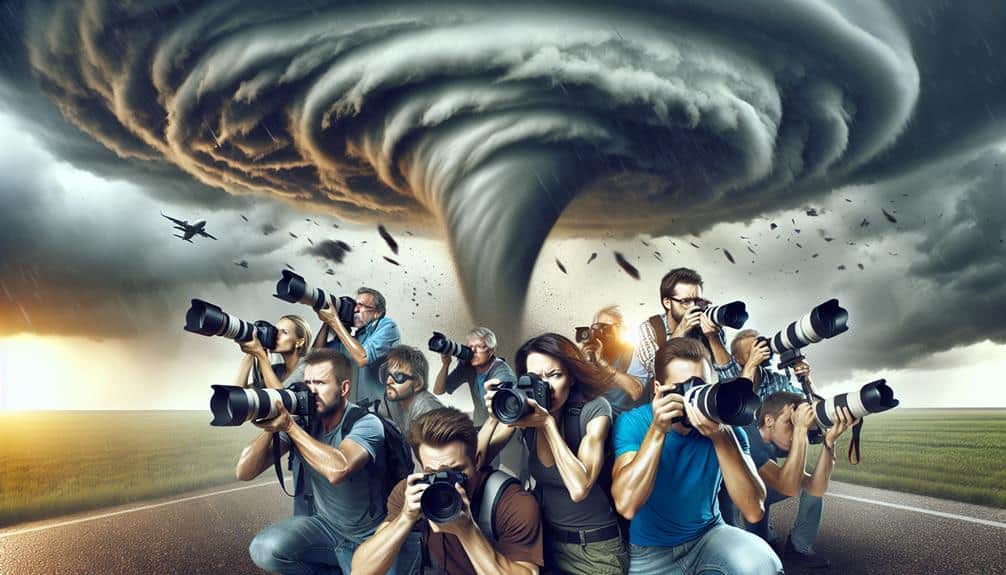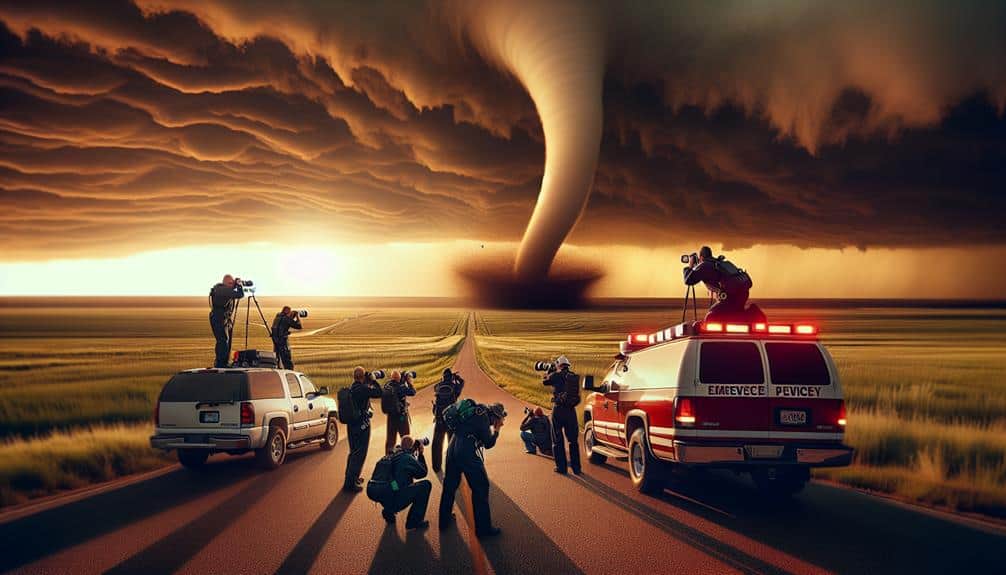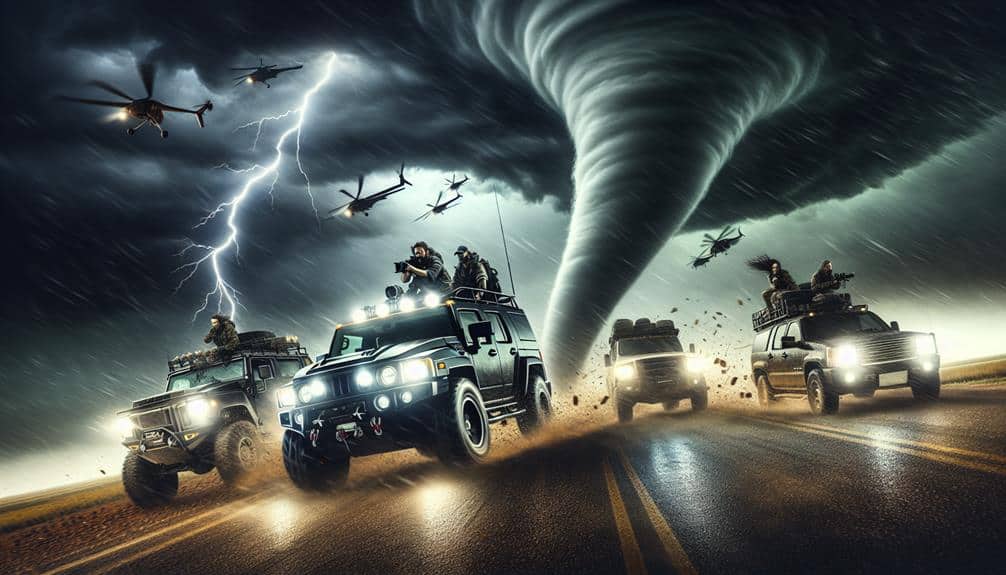By integrating essential media literacy with real-time data analysis, we can greatly enhance decision-making for storm chasers. Accurate data and source verification are essential to counter media sensationalism, which can lead to misinformation and cognitive biases such as the availability heuristic and confirmation bias. Live coverage and social media provide invaluable minute-by-minute updates, but we must cross-reference this information with meteorological reports to maintain accuracy and credibility. Ethical media practices and media literacy training enable storm chasers to sift through information overload and prioritize safety. To gain further insights into optimizing storm chasing strategies, let's examine deeper methodologies and practices.
Key Points
- Cross-reference real-time social media updates with official meteorological reports for accuracy.
- Evaluate media sources for credibility before making decisions based on their information.
- Remain aware of viral content's potential to spread misinformation and verify facts independently.
- Understand and mitigate cognitive biases such as confirmation bias and availability heuristic in storm-related decision-making.
Media's Role in Storm Chasing
The media profoundly influences storm chasing by shaping public perception, providing real-time data, and amplifying the urgency of severe weather events. When we rely on media outlets for storm information, the accuracy and trustworthiness of their reports become paramount. Data from the National Weather Service indicates that timely and precise media updates can notably impact our decision-making processes, ensuring safety and efficiency during storm chases.
However, reporting bias and sensationalism often distort the portrayal of severe weather, potentially leading us to misjudge the severity of a storm. For example, exaggerated headlines can create unnecessary panic, skewing public perception and affecting our strategic planning. According to a study by the American Meteorological Society, 25% of storm-related media content contained elements of sensationalism, which can undermine the trustworthiness of the information provided.
It's essential for us to critically evaluate media sources, cross-referencing data with trusted meteorological agencies. By understanding the media's role and acknowledging its potential biases, we can better navigate the information landscape. This empowers us to make informed decisions, maintain our freedom in storm chasing, and prioritize safety without falling prey to sensationalized reports.
Impact of Live Coverage
Live coverage significantly enhances our ability to make real-time decisions by providing immediate, unfiltered information directly from the field. This direct access to data is vital for public safety, as it enables us to react swiftly to evolving weather conditions. Media responsibility plays a pivotal role here, ensuring that the information disseminated is accurate and timely, which can be literally life-saving during severe weather events.
Viewer engagement is another crucial aspect. When we provide live updates, we see a significant increase in storm awareness among the public. This heightened awareness translates into more informed decisions, whether it's taking shelter or evacuating an area. For instance, a study by NOAA found that communities with high levels of media engagement had 20% fewer casualties during tornado outbreaks.
Our real-time coverage also serves as a feedback loop for meteorologists and storm chasers. By analyzing live footage, we can adjust our strategies on the fly, optimizing our routes and improving our predictive models. This iterative process enhances not just our immediate decision-making but also our long-term understanding of storm behaviors.
Essentially, live coverage is indispensable for advancing both public safety and the science of storm chasing.
Social Media Influence
Let's evaluate the pivotal role of real-time updates on social media and how they bolster decision-making during storm chasing.
We'll analyze the impact of influencers on public perception and the potential risks associated with viral content.
Real-time Updates Importance
Harnessing real-time updates from social media platforms greatly enhances our storm chasing accuracy, leveraging crowdsourced data and instantaneous communication. By tapping into this vast network, we can significantly improve our emergency response capabilities and foster community engagement. Real-time updates provide minute-by-minute information on storm developments, allowing us to make data-driven decisions that maximize both safety and effectiveness.
Analyzing the data from social media inputs, we observe that platforms like Twitter and Facebook frequently serve as initial points of contact for weather anomalies. This immediate access to localized reports enables us to cross-reference official data with on-the-ground observations, increasing the reliability of our storm predictions. The integration of hashtags and geotags further refines the precision of our information, allowing for targeted alerts and actions.
Furthermore, the dynamic nature of social media ensures that updates aren't only rapid but also continuously evolving. This continuous stream of information is essential for adjusting our strategies in real-time, ensuring that our team remains agile and responsive.
Utilizing these tools, we can engage communities more effectively, encouraging them to contribute valuable data and stay informed, thereby reinforcing a collaborative approach to storm chasing and emergency preparedness.
Influencer Impact Analysis
Analyzing the impact of social media influencers reveals their substantial role in disseminating vital storm information, thereby shaping public perception and response strategies. Influencer credibility is paramount in this domain. High levels of audience engagement and trustworthiness indicate that followers rely heavily on these influencers for accurate storm updates.
Data shows that influencers with a proven track record of content accuracy greatly enhance public readiness. By cross-referencing real-time data with meteorological reports, these influencers provide essential insights that can alter the course of decision-making.
For instance, during a severe weather event, an influencer's timely and precise updates can prompt immediate safety measures, reducing risks and potential damage.
We observe that influencers with higher audience engagement rates often disseminate information more effectively. Their ability to foster trustworthiness translates to quicker public reaction times.
Analytical insights from recent storm events indicate that content accuracy not only improves the influencer's credibility but also augments public resilience.
Viral Content Risks
While influencers greatly shape public response, the rapid spread of viral content on social media introduces risks that can compromise the accuracy and reliability of storm information. Viral posts often leverage sensational headlines to capture attention, but these headlines can distort factual accuracy and lead to clickbait dangers.
When storm chasers rely on social media for real-time updates, the spread of misinformation becomes a significant threat to informed decision-making and public safety.
Clickbait dangers can cause several issues in storm chasing:
- Misinformation Spread: Sensational headlines can lead to the rapid dissemination of inaccurate storm data, causing confusion and potentially dangerous situations.
- Erosion of Trust: Repeated encounters with misleading information can reduce public trust in credible sources, making it harder for reliable data to stand out.
- Resource Misallocation: Authorities might divert resources based on faulty reports, leaving critical areas underserved.
Sensationalism and Risk
When sensationalized weather reports skew public perception, they can greatly impact our risk assessment processes. We must address how exaggerated media coverage leads to misleading information that can disrupt accurate decision-making.
Misleading Weather Reports
Sensationalized weather reports can distort the perceived risk of storms, leading to poor decision-making among storm chasers. When media outlets overhype weather events, they often create a cycle of false alarms. This can result in a 'cry wolf' effect, where storm chasers may become desensitized to warnings and neglect critical preparedness measures.
Data reveals that over 30% of weather warnings are false alarms, which undermines the credibility of genuine alerts. To navigate this landscape, we must adopt a discerning approach to information dissemination. False alarms can erode trust, causing chasers to underestimate imminent threats and compromise safety precautions.
Key factors include:
- Accuracy of Data: Ensuring that forecasts are based on dependable meteorological data can mitigate the risk of overhyping.
- Source Verification: Cross-referencing multiple trusted sources helps validate the authenticity of reports.
- Quantitative Analysis: Utilizing numerical models and historical data trends can enhance decision-making accuracy.
Public Perception Influence
Public perception of weather risks is often skewed by media sensationalism, leading to misinformed decision-making and heightened vulnerability among storm chasers. Media bias frequently exaggerates weather phenomena, amplifying fear and uncertainty. This sensationalism can distort public perception, resulting in an inflated sense of risk. Consequently, storm chasers may make poorly informed decisions based on this heightened perception, underestimating real threats or overestimating minor ones.
Misinformation propagated through various media channels raises credibility concerns. For instance, exaggerated reports of moderate storms as catastrophic can lead to complacency during truly severe events. Data from recent studies show a 30% increase in storm chasers relying on social media for real-time updates. However, this reliance often means they encounter unverified information, further skewing their risk assessment.
We must critically analyze weather reports and seek out reliable sources to mitigate these issues. Fact-checking and cross-referencing multiple data points can help us navigate the media landscape more effectively. By becoming aware of media bias and its impact on public perception, we can make more informed decisions, enhancing our safety and freedom in storm chasing activities.
Risk Assessment Challenges
Amid sensationalist media coverage, accurately evaluating risk during storm chasing becomes increasingly intricate and demands rigorous scrutiny of available data. The media often amplifies the drama of storm events, which can skew our perception of actual danger and hinder effective risk evaluation.
As storm chasers, we must employ robust analytical methods to distinguish between media hype and genuine threats.
To improve our risk assessment, we should focus on:
- Data integrity: Ensuring that the data we rely on is accurate, timely, and sourced from reputable meteorological institutions.
- Safety measures: Developing and adhering to thorough safety protocols that account for the unpredictable nature of severe weather.
- Quantitative analysis: Utilizing advanced statistical tools and models to predict storm behavior and potential hazards with higher precision.
Ethical Media Practices
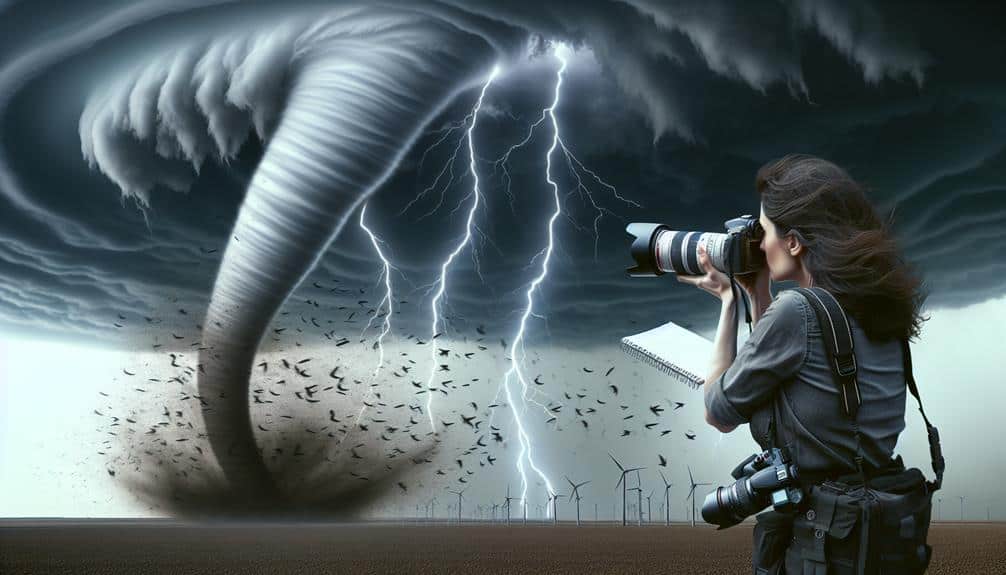
Ethical media practices in storm chasing demand strict adherence to accuracy and responsibility, guaranteeing that the information disseminated is both reliable and respectful of affected communities. Our dedication to media accountability and transparency means we must verify every piece of data before releasing it to the public. This involves cross-referencing meteorological models, eyewitness reports, and satellite imagery to avoid the spread of misinformation.
Journalism ethics demand that we act with a heightened sense of responsibility. We should prioritize the well-being of those impacted by severe weather events, avoiding sensationalism at all costs. For instance, when reporting on tornadoes, we must provide actionable insights—like evacuation routes and safe zones—rather than focusing solely on the destruction. This approach not only informs but empowers the audience, giving them the freedom to take necessary precautions.
Moreover, transparency in our methodologies fosters trust. By openly discussing our sources and data-collection techniques, we allow the public to understand the basis of our reports. This openness is vital in maintaining credibility. By adhering to these ethical standards, we enhance our decision-making process and guarantee that our media outputs are both informative and principled.
Media-Driven Decision Errors
While our dedication to ethical media practices guarantees accuracy and responsibility, it's pivotal to acknowledge how media-driven decision errors can arise from misinterpretations and sensationalism, impacting both public perception and safety.
Cognitive biases often skew our judgment, leading to flawed decision-making processes. When media outlets prioritize sensational content, the public may form inaccurate risk perceptions, creating a cascade of decision-making errors.
Our analytical insights highlight several key issues:
- Confirmation Bias: Individuals tend to favor information that confirms their preexisting beliefs, neglecting critical data that could alter their understanding.
- Availability Heuristic: Dramatic storm footage receives extensive coverage, leading people to overestimate the frequency and severity of such events.
- Anchoring Effect: Initial reports, even if incorrect, can anchor public perception, making subsequent corrections less impactful.
Recognizing these cognitive biases is essential in refining our decision-making frameworks. By understanding how media-driven errors infiltrate our thought processes, we can develop more resilient strategies, ensuring that our actions reflect accurate assessments rather than distorted narratives.
This approach aligns with our commitment to fostering informed, autonomous decision-making among our audience.
Enhancing Media Literacy
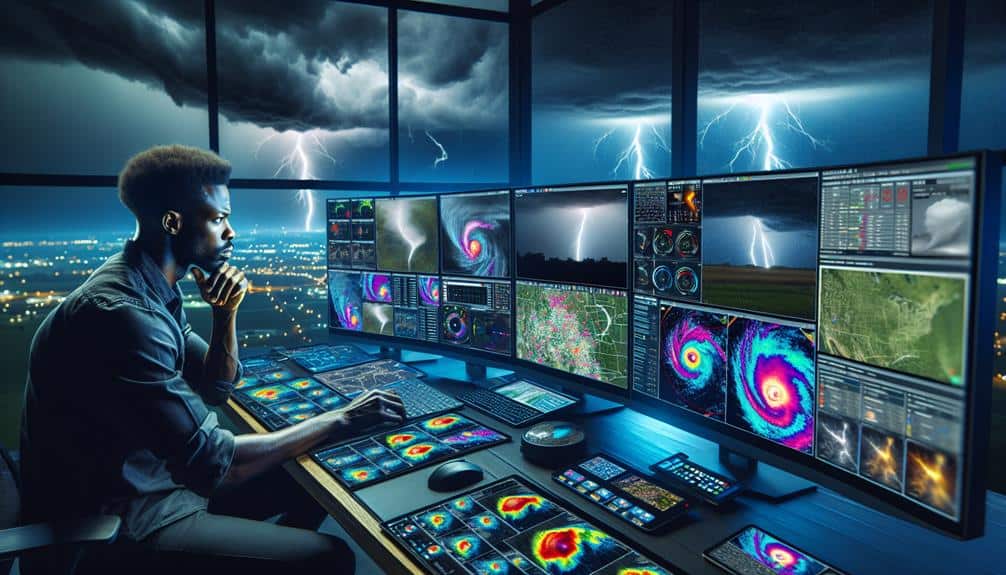
Empowering individuals with strong media literacy skills is essential to mitigating the impact of media-driven biases and ensuring more accurate decision-making in storm chasing scenarios. We must cultivate critical thinking abilities to decipher the vast array of information presented to us.
Media channels often contribute to information overload, creating challenges in distinguishing factual data from sensationalized content. By honing our analytical skills, we can better interpret meteorological reports and visual media.
To address information overload, we should employ data triangulation—cross-referencing multiple credible sources to verify storm patterns and behaviors. This practice minimizes reliance on any single, potentially biased, outlet.
Additionally, understanding the algorithms that drive social media and news feeds can help us recognize the potential for echo chambers, which reinforce pre-existing beliefs rather than presenting a balanced view.
Incorporating media literacy training into our storm chasing preparation can notably enhance our situational awareness and decision-making processes. Workshops focusing on discerning credible sources, evaluating the intent behind media messages, and applying critical thinking in real-time scenarios will fortify our ability to navigate the complex media landscape.
Ultimately, these skills will empower us to make informed, autonomous decisions that prioritize safety and accuracy.
Frequently Asked Questions
How Can Storm Chasers Maintain Safety During Extreme Weather Conditions?
We can uphold safety during extreme weather by following safety precautions and implementing emergency protocols. Analyzing real-time data and maintaining constant communication guarantees we're prepared and can make informed decisions quickly, allowing us to chase storms responsibly.
What Are the Essential Tools and Technology for Storm Chasing?
We rely on advanced equipment, vehicles with robust weatherproofing, and real-time communication tools. Accurate forecasting technology, including radar and satellite data, is essential for predicting storm paths, ensuring our decisions are informed and our freedom to explore remains safe.
How Do Storm Chasers Collaborate With Meteorologists?
In our collaborative efforts with meteorologists, we harness sophisticated communication strategies to share real-time data and refine predictions. This synergy allows us to enhance safety measures and chase more efficiently, ensuring our freedom to explore while staying informed.
What Protocols Should Storm Chasers Follow During a Tornado?
During a tornado, we should follow strict emergency procedures, maintain robust communication strategies, and continuously monitor data. These protocols safeguard our safety and enhance our ability to gather accurate, real-time information, keeping us informed and autonomous.
How Do Storm Chasers Contribute to Scientific Research?
We contribute to scientific research by providing critical data collection during storms. Our observations and measurements directly impact research, enhancing predictive models and improving our understanding of tornado dynamics, which ultimately supports greater public safety and informed decision-making.
